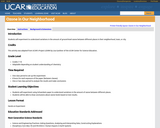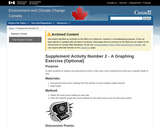
Students will experiment to understand variations in the amount of ground-level ozone between different places in their neighborhood, town, or city.
- Provider:
- UCAR
- Author:
- UCAR
- Date Added:
- 06/24/2019

Students will experiment to understand variations in the amount of ground-level ozone between different places in their neighborhood, town, or city.

A lab activity to look at how transportation influences air quality.

Graph reading and data analysis are highlighted in this activity where students identify the countries that produce the highest levels of polluting atmospheric emissions. They compare these data with the population of the countries, and describe how the percentage of total emissions and total population numbers are related. The resource includes the graph and a student worksheet. This is an activity from Space Update, a collection of resources and activities provided to teach about Earth and space. Summary background information, data and images supporting the activity are available on the Earth Update data site.

This quiz assesses student knowledge of clouds and aerosols.

This quiz assesses student knowledge about air quality.

This course was created by the Rethink Education Content Development Team. This course is aligned to the NC Standards for 7th Grade Science.

This course was created by the Rethink Education Content Development Team. This course is aligned to the NC Standards for 7th Grade Science.

This course was created by the Rethink Education Content Development Team. This course is aligned to the NC Standards for 7th Grade Science.

This curricular unit is meant to engage students in scientific inquiry and hands-on measurement of the atmosphere. The lessons enable students to apply math and science to explore the challenge of air pollution in their own community.

This brief video lesson discusses smog and what it is composed of. Discussion/assessment questions and suggested supplemental resources are also included.

This resource describes air quality and how it can be affected by pollution and smog.

Students measure the ground-level ozone in their area and examine the trend over a specific length of time.

This article discusses how the Multi-angle Imaging SpectroRadiometer (MISR) instrument found on the Terra satellite is used to understand how particles in the atmosphere interact with sunlight and how particle pollution affects Earth's climate. Directions for building a demonstration model of MISR out of cardboard tubes is included, along with short activities to show how it's multiple viewing angles allow MISR to differentiate the kinds of particles in the air because they scatter light differently, depending on their size, shape, and composition.

Students will work in groups to determine whether air quality is better today than it was in 1970. Students will complete a KWL chart and make suggestions to improve air quality today. This lesson utilizes documents from the North Carolina State Government Publications Collection.

Students examine the causes and effects of air pollution, as well as ways in which various industries and government organizations are aiming to control it. Students first use the Internet to answer a series of questions about air pollution and to compile a list of related Web sites, and then use these Web sites to create informative posters about specific air pollution topics.

What Is Air? Is a brief introduction to the properties of air using two It’s Our Air videos (http://www.itsourair.org) with a student worksheet for evaluation. (www.itsourair.org).

In this lesson, students develop an understanding of the effects of invisible air pollutants with a rubber band and hanger air test and a bean plant experiment. They also learn about methods of reducing invisible air pollutants.

In this project-based lesson, students read an article about weather. Then they will conduct further research on weather topics and create a book of weather terms related to how weather is monitored and measured.

This encyclopedia entry is for the term "ozone layer." The ozone layer is one layer of the stratosphere, the second layer of the Earth?s atmosphere. The stratosphere is the mass of protective gases clinging to our planet. This entry discusses what the ozone layer does for us and how we are impacting the layer. Text for this entry is appropriate for the middle and high school grade levels.